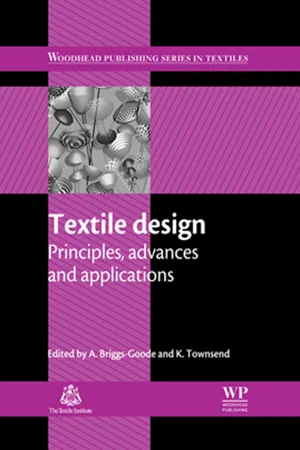
Textile Design
Principles, Advances and Applications
A Briggs-Goode,K Townsend
- 408 Seiten
- English
- ePUB (handyfreundlich)
- Über iOS und Android verfügbar
Textile Design
Principles, Advances and Applications
A Briggs-Goode,K Townsend
Über dieses Buch
Textile design is a complex field of practice which operates in a competitive, global industry. Designers need to take into account not only the design but also the manufacture, technological development and application of the final product. Textile design provides a broad overview of the fundamentals of and advances in textile design, as well as practical case studies of relevant industries.Part one covers the principles of fabric construction as applied to textile design, with chapters on fundamental principles, woven and knitted textile design. Part two discusses surface approaches to textile design, with chapters on such topics as surface design of textiles, printed and embroidered textile design, dyeing and finishing and the use of colour in textile design. Finally, part three focuses on the applications and advances in textile design, including chapters covering colour trend forecasting, sustainable textile design, fashion, interior and 2D to 3D design considerations and new developments in technical and future textiles.With its distinguished editors and international team of contributors, Textile design is an essential reference for design professionals in the textile and fashion industries, as well as those who specialise in interior textiles and academics with a research interest in the area.
- A broad overview of textile design covering fundamental topics such as principles of fibres and fabrics, knitted fabric design, through to the dyeing, finishing and printing aspects of textile design
- Explores the design aspects of technical textiles and future textiles
- An invaluable source of information on textile design and suitable for design professionals in the textile and fashion industries, as well as those in academia
Häufig gestellte Fragen
Information
Fibres, yarns and fabrics: fundamental principles for the textile designer
Abstract:
1.1 Introduction
























1.2 Basic principles of fibres, yarns and fabrics
1.3 Main types of fibres, yarns and fabrics, and their production methods
1.3.1 Fibres
Natural fibres
Inhaltsverzeichnis
- Cover image
- Title page
- Table of Contents
- Copyright
- Contributor contact details
- Woodhead Publishing Series in Textiles
- Foreword
- Introduction
- Part I: Principles: fabric construction approaches to textile design
- Part II: Principles: surface approaches to textile design
- Part III: Applications and advances
- Index